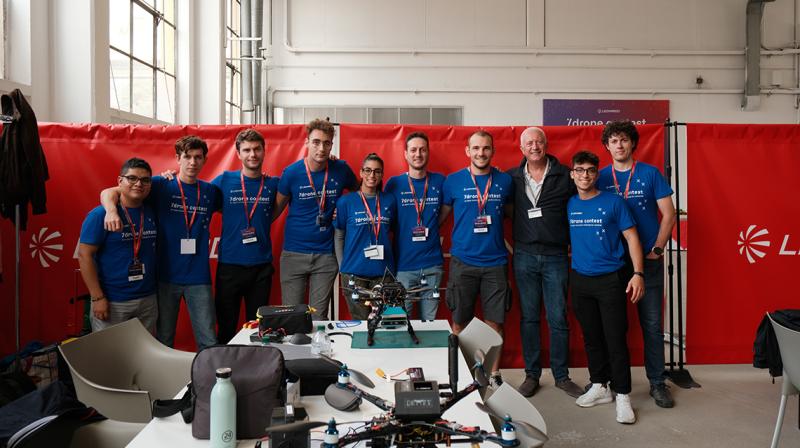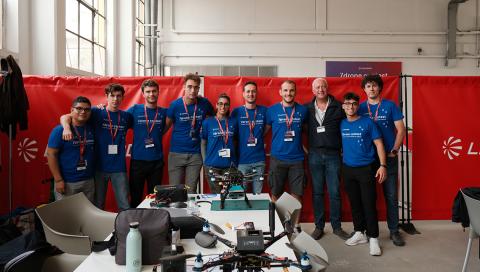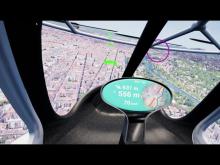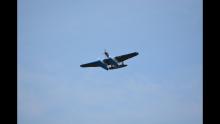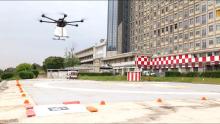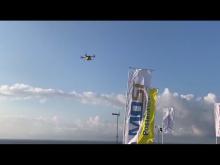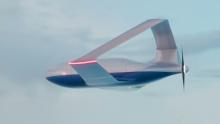In a few years, the skies above our cities—and beyond—will be filled with drones of all sizes: a scenario that the Politecnico di Torino is working to support through technological development, as well as by seeking answers to the questions this new context raises.
Drones and small autonomous aerial vehicles are already turning the sky into an urban space to be designed, and at the Politecnico, researchers are exploring various aspects related to this new perspective. Here, drones are envisioned for a wide range of applications, from delivering medicines to transporting organs, monitoring fields, and intervening in emergency situations.
Predictive models, new regulations, and intelligent interfaces to integrate these aerial vehicles into the urban fabric are all areas of study, with artificial intelligence emerging as a key tool for designing safe and sustainable solutions. Yet, common questions arise: how to ensure safety, reduce noise, protect privacy, and adapt to new concepts of urban mobility?
It may soon be possible to fly small aircraft over houses, as well as larger aerial vehicles capable of longer journeys to transport people and goods. There is even consideration of drawing inspiration from iconic past designs, while employing innovative and sustainable materials.
by PoliTO Student Team DRAFT. Academic Advisor: Elisa Capello
One of the most pressing challenges in the widespread adoption of drone technology is ensuring their autonomy. As drones become more integrated into everyday applications—from logistics to environmental monitoring—the need for them to operate independently, safely, and efficiently becomes critical. Artificial Intelligence (AI) is emerging as a transformative force in this domain, offering new ways to rethink autonomy through intelligent decision-making, adaptive navigation, and real-time data processing.
The student team DRAFT PoliTo, founded in 2019 at Politecnico di Torino, is at the forefront of this innovation. The team is dedicated to researching and developing AI-driven solutions that enhance the autonomy of current drone systems. By integrating machine learning algorithms and advanced control systems, DRAFT PoliTo pushes the boundaries of what drones can achieve without human intervention.
Beyond its technical mission, the team fosters a vibrant, multicultural, and multidisciplinary community. Its members come from diverse academic backgrounds and levels of study, united by a shared passion for robotics, AI, and aerospace innovation. Through participation in international competitions and collaborative projects, DRAFT PoliTo empowers students to grow both technically and socially, preparing them to lead the future of autonomous aerial systems.
by MOST, Centro Nazionale per la Mobilità Sostenibile (National Center for Sustainable Mobility). PoliTo Team: Fabrizio Lamberti, Gabriele Pratticò, Lorenzo Valente
Electric Vertical Take-Off and Landing (eVTOL) aircraft are poised to revolutionize the future of mobility by merging the vertical lift capabilities of helicopters with the efficiency and environmental benefits of electric propulsion. At the forefront of this technological evolution is Politecnico di Torino (PoliTO), which plays a leading role in advancing eVTOL research, particularly within the context of Urban Air Mobility (UAM).
PoliTO's contribution in this field is both practical and forward-thinking, as demonstrated by the development of an eVTOL flight simulator in immersive Virtual Reality. This simulator primarily serves as a testbed for designing and validating advanced Human-Machine Interfaces with a specific focus on the passenger. By simulating the entire travel experience, from take-off to landing, coexistent air traffic, multiple weather and visibility conditions, and uncommon stressful events, researchers can analyze interactions, test new interface concepts, and gather relevant data to create intuitive and comfortable systems that enhance the overall onboard experience. This aspect becomes particularly crucial in a future scenario where these vehicles will become autonomous, as effective HMIs will be essential to increasing passenger trust and confidence when no pilot is onboard.
As urban areas become increasingly congested, eVTOLs offer a promising solution for fast, direct aerial transport. Their electric propulsion systems contribute to reducing carbon emissions, aligning with global sustainability goals. Furthermore, the transition to autonomous vehicles is key, as it will help further increase the efficiency of the transport system and reduce the carbon footprint, a significant factor for vehicles that typically have a small seating capacity (2-8 passengers). PoliTO's research is not only technically advanced but also visionary, aiming to make eVTOLs a scalable and economically viable component of future urban transportation systems.
The Savoia Marchetti S55 X seaplane is a symbol of the remarkable aeronautical knowledge achieved in Italy in the early 1900s, confirmed by a series of long-distance record flights. In 2015, a group of skilled and enthusiastic aviation professionals launched the “Replica55” project with the aim of designing, building, and flying a replica of the S55 X seaplane.
The past and future of aviation are intertwined in the HERA (High Efficiency Replica Aircraft) project: the geometric designs of the original aircraft's structure were the starting point for the construction of the 1:8 scale replica by the S55 student team. The aircraft was built using cutting-edge materials and technologies The prototype was built using cutting-edge materials and technologies and the full-electric version successfully flew for the first time in October 2024. Building on this achievement, the team now aims to go further, to develop the world’s first hydrogen-powered, high-range seaplane, capable of replicating — on a scaled basis — the historic flights of the legendary S55 X. A high-specific-energy power system based on hydrogen fuel cells will be used, with the ambition of producing electricity with water as the only combustion product.
by Fondazione D.O.T. in collaboration with DIMEAS PoliTO - Pic4Ser Interdepartmental Center (coord. Marcello Chiaberge) and the startup ABzero
Led by the Fondazione D.O.T. (Organ and Transplant Donation Foundation) in collaboration with PIC4SeR (PoliTo Interdepartmental Centre for Service Robotics) and the startup ABzero, the project proposes solutions for moving transplant organs and biological samples with drones. Also collaborating in the development of the project are Città della Salute, the University of Turin, the Turin Municipality, the Regional Transplant Center of Piedmont and Valle d'Aosta, the National Transplant Center, and ENAC.
This marks a new frontier for the use of drones in the civil sector, with numerous advantages, above all, speed and safety, which will significantly increase by eliminating the need for road transfers. There will also be a positive change in terms of costs, with reduced prices in exchange for greater efficiency in meeting the number of requests. The ability to guarantee the arrival of organs and biological material at hospitals, within agreed time frames and protocols, will help stabilize the trend of transplants and donations, even in the most disadvantaged and remote areas of the country.
by MOST – Centro Nazionale per la Mobilità Sostenibile (National Center for Sustainable Mobility), Spoke 1 Air Mobility. Industrial partners Poste Italiane and Leonardo. Spoke Coord: Giorgio Guglieri
The goal of the project is to test a daily cargo transport system using drones capable of carrying loads of up to 40 kilograms. This initiative is part of the Research and Innovation Program of the National Center for Sustainable Mobility (MOST). It is funded by the Italian Ministry of University and Research (MUR) under Mission 4.2, through resources from the National Recovery and Resilience Plan (PNRR - NextGenerationEU).
Promoted by Poste Italiane and Leonardo, the initiative is part of Spoke 1 – Air Mobility, coordinated by Politecnico di Torino. It involves the use of cargo drones, provided and remotely piloted by the company FlyingBasket. These drones take off from Bagnoli (Naples) and land on the island of Procida with their payload. All operations are managed from a control station operating in Beyond Visual Line Of Sight (BVLOS) mode.
The take-off and landing areas are set up by UrbanV and are equipped with systems that ensure the safe handling of goods, while also offering temporary shelter for equipment and control systems.
The project is supervised in terms of regulatory and authorization aspects by the Italian Civil Aviation Authority (ENAC) and is supported by the Government Commissioner for the Bagnoli-Coroglio Area, Invitalia, the Campania Region, the Municipality of Procida, and the Campania Aerospace District.
By PoliTO Department of Mechanical and Aerospace Engineering - DIMEAS. The team: Angelo Lerro, Gioacchino Cafiero
ThrustPod, a patented solution from Politecnico di Torino, uses extractable thrusters to generate a vertical thrust to allow a fixed-wing aircraft to take off and land vertically. The system design is autonomous: its structure includes electric motors, ducted propellers, control boards and batteries necessary for the hovering phases. Furthermore, it is modular because the number of engines is linked to the maximum weight of the aircraft for which it is intended. The use of the ThrustPod allows for the separation of the fixed-wing and rotary-wing phases, permitting them to be optimized independently. Also, it does not require tilting motors or structural parts for piloting or controlling the aircraft, introducing a significant advantage in terms of maintenance. Therefore, ThrustPod is an innovative solution for urban air mobility that can be easily certified as it is based on off-the-shelf components.
The patent is now being implemented by SUPAIR, a PoliTO spin-off, which develops an end-to-end aerial systems for urban air mobility implementing the ThrustPod, a modular propulsion system enabling the vertical take-off and landing of fixed wing aircraft and, therefore, meeting the requirements for the operations in the urban environment. The system can be used both to convert existing fixed-wing aircraft and to optimize the design of new aircraft for urban mobility.
